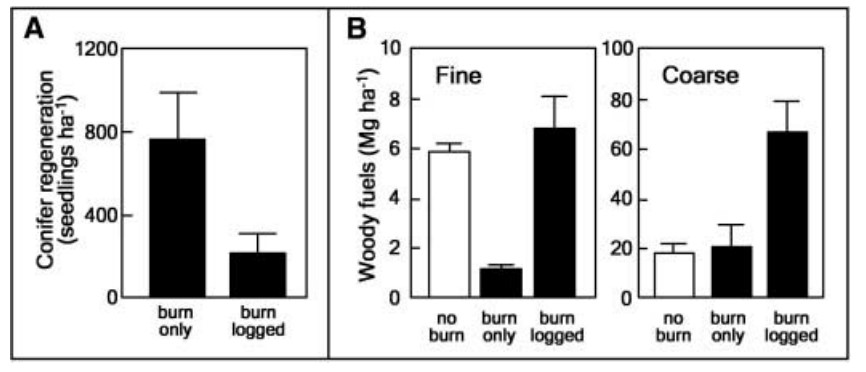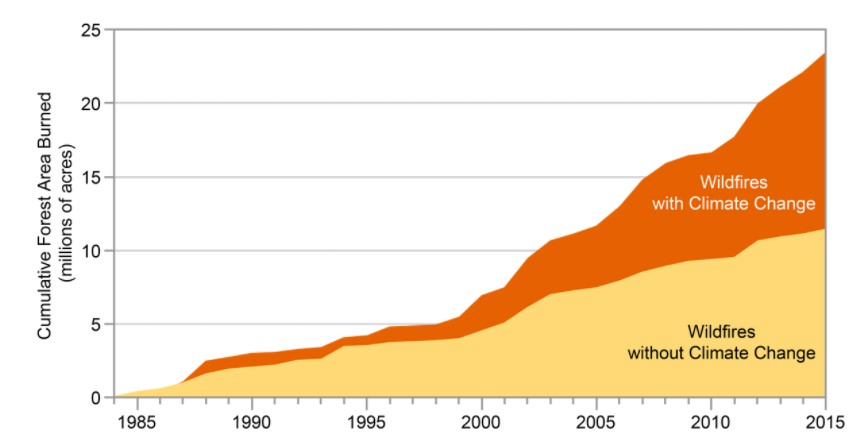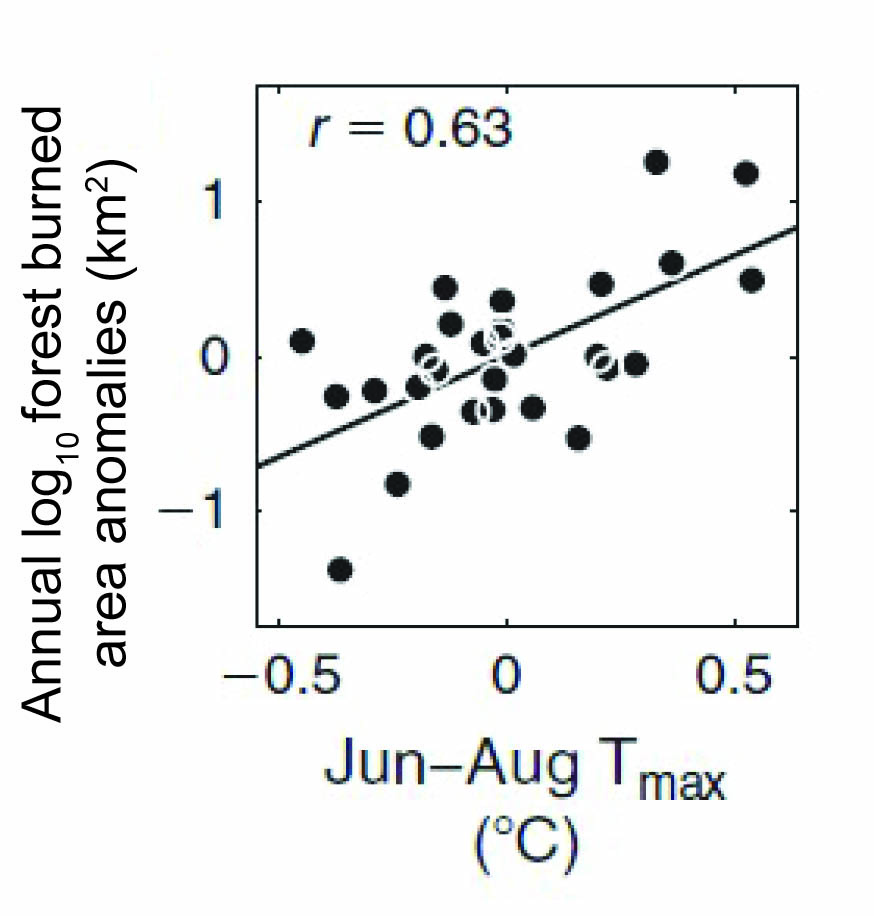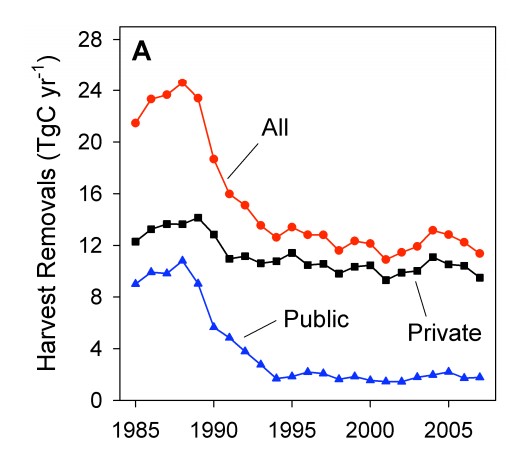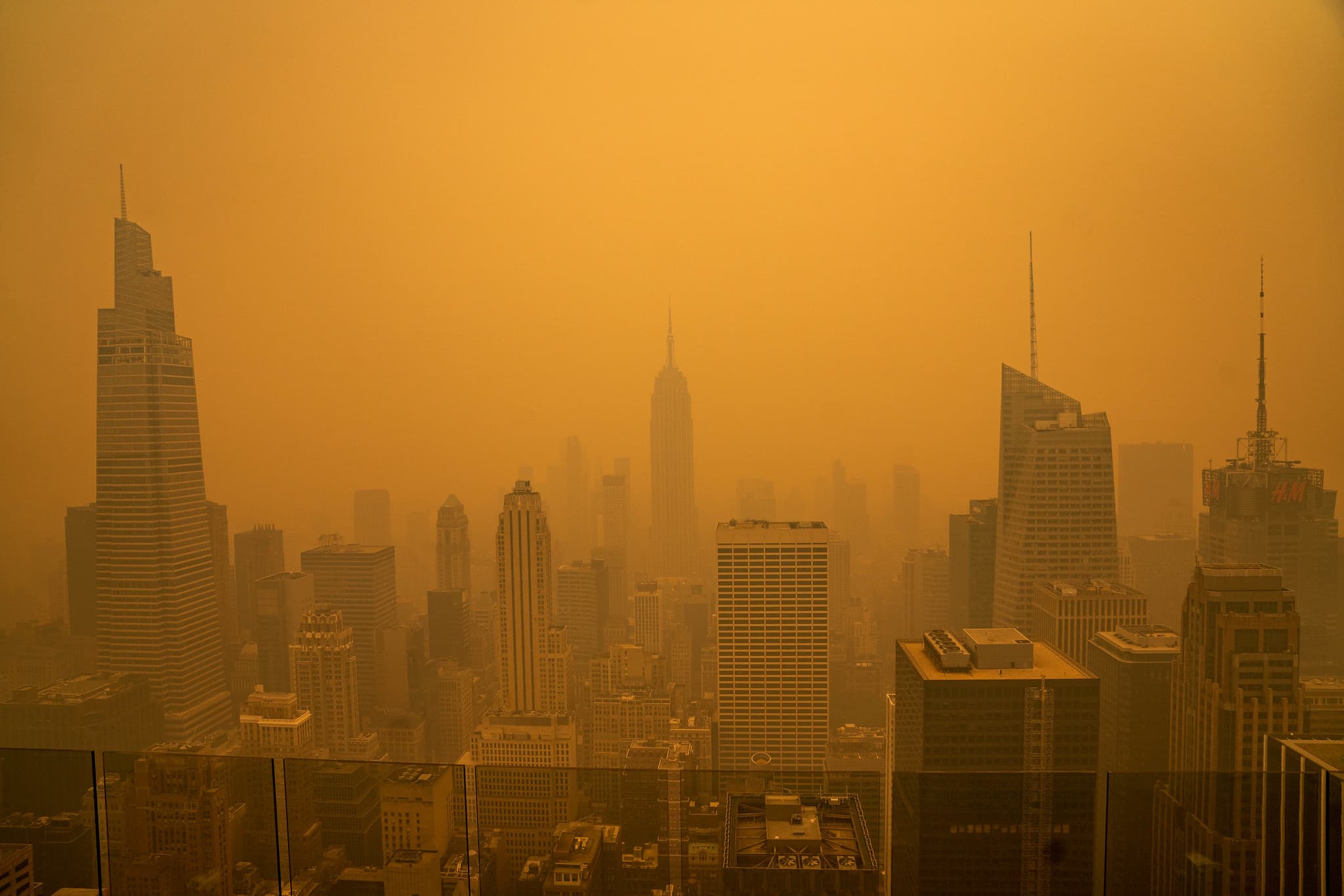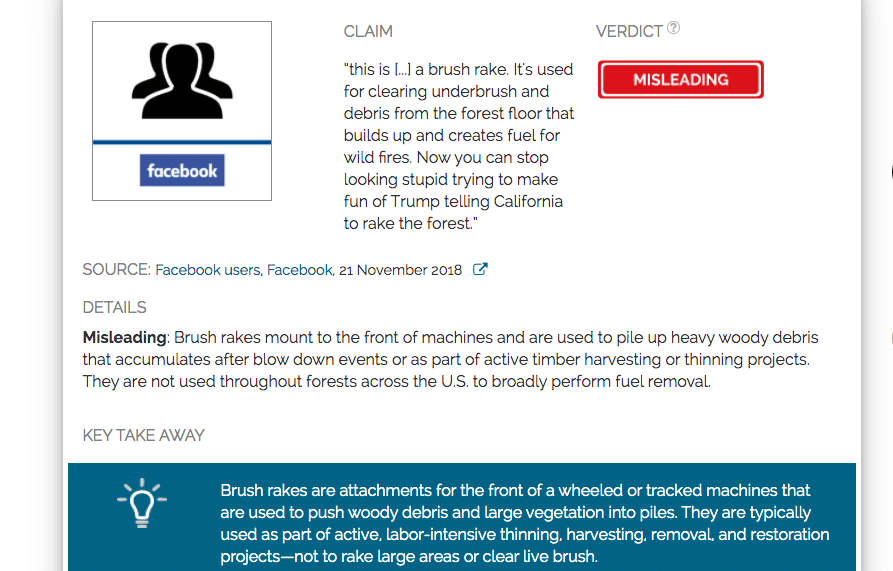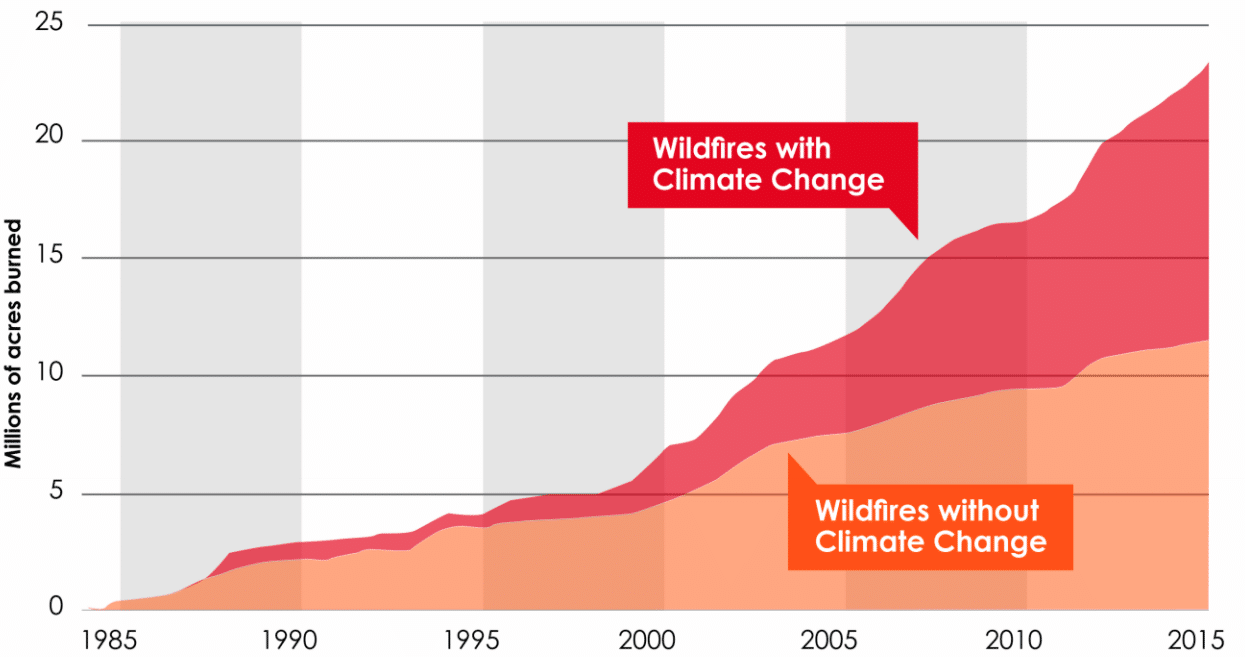- Climate
Article by The Daily Caller oversimplifies drivers of wildfires and downplays role of climate change
Reviewed content
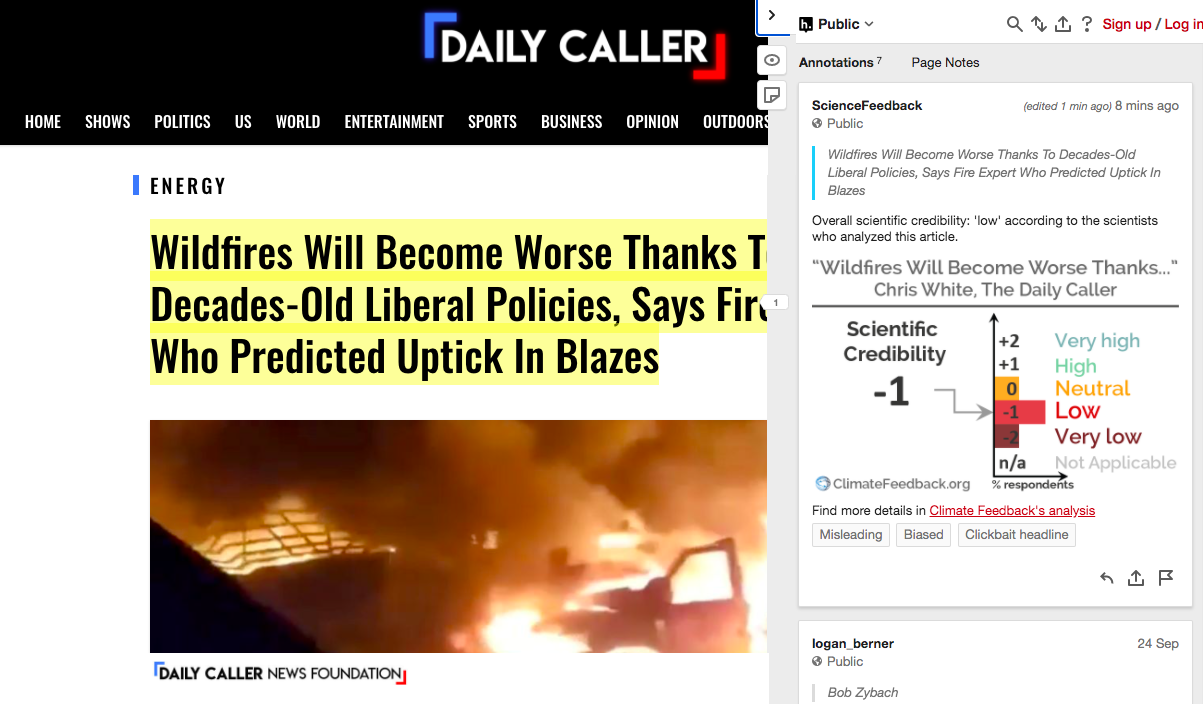
Headline: "Wildfires Will Become Worse Thanks To Decades-Old Liberal Policies, Says Fire Expert Who Predicted Uptick In Blazes"
Published in The Daily Caller, by Chris White, on 2020-09-13.
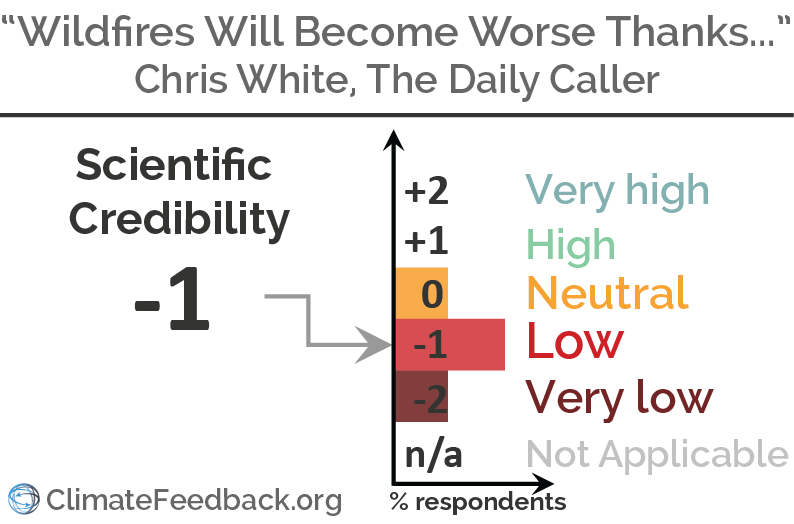
Summary
The article in The Daily Caller claims that land management practices enacted during the Clinton administration “paved the way for future debilitating wildfires.” The article received over 45,000 interactions on Facebook as of 28 Sept 2020, according to the social media analytics tool CrowdTangle. The article also appears on other media outlets, including The Daily Signal, The Stream, and Citizens Journal. Scientists who reviewed this article found that the article oversimplifies the complex drivers of wildfires in the western US and misleads readers by stating that land management practices enacted during the Clinton administration are the almost exclusive cause of severe wildfires today.
Specifically, the article states, “Former President Bill Clinton made a significant change to federal land management nearly 30 years ago that created the conditions necessary for massive wildfires to consume portions of the West Coast.” While land management practices, such as fire suppression do influence wildfire behavior, these practices were implemented long before the Clinton administration.
In the US, federal forest-fire management began in 1886 with the creation of the National Parks[1]. Forest reserves, which are now known as “National Forests,” were established a few years later, and in 1905, Gifford Pinchot became the first head of the United States Forest Service. As described in Stephens and Ruth (2005), “under his direction a national forest-fire policy was initiated. The suppression of forest fires dominated early forest policy.”[1]
This legacy of fire suppression in the US has persisted for more than a century, leading to an accumulation of trees and woody debris that fuels intense wildfires[2]. Contrary to these practices, many forested ecosystems in the western US are adapted to frequent, low-level, low-intensity fires[3]. Forest management practices, such as thinning and prescribed burns, can reduce fuel loads and the risk of severe wildfires, writes Valerie Trouet, an associate professor at the University of Arizona. However, other forest management practices, such as logging post-wildfire, can hinder tree regeneration and increase fire risk by increasing fuel loads (see figure below)[4].
Figure—Effects of wildfire and logging on seedling regeneration and woody fuels after the 2002 Biscuit Fire in Oregon, US. (A) Post-wildfire logging reduced conifer seedling regeneration in burned forest plots by 71%. (B, C) Post-wildfire logging increased fine and coarse woody debris. From Donato et al. (2006)[4].
In addition to forest management practices, human-caused climate change is a key driver of wildfire severity[2,5,6]. Specifically, climate change is causing warmer and drier conditions that increase the amount of dry vegetative fuel and total area burned during wildfires in the western US. As described in Abatzoglou and Williams (2016), “human-caused climate change caused over half of the documented increases in fuel aridity since the 1970s and doubled the cumulative forest fire area since 1984,” (see figure below)[5].
Figure—Cumulative forest area burned by wildfires in the western US from 1984-2015. From Fourth National Climate Assessment (2018)[2].
These data and trends contrast with multiple claims in the article, including “‘The lack of active land management is almost 100 percent the cause,’ he told the DCNF, noting that climate change has almost nothing to do with fire kindling gathering across the forest floors,” and “‘Global warming may contribute slightly, but the key factors are mismanaged forests, years of fire suppression, increased population, people living where they should not, invasive flammable species, and the fact that California has always had fire,’ University of Washington climate scientist Cliff Mass told TheDCNF in 2018.”
Forest management policies, climate change, an increase in the number of people living close to wildlands, and numerous other factors influence the behavior of wildfires in the western US. While the article acknowledges the importance of forest management policies, it overlooks the role of climate change and other important drivers of wildfires, creating an oversimplified narrative that misleads readers.
See all the scientists’ annotations in context. You can also install the Hypothesis browser extension to read the scientists’ annotations in context.
Reviewers’ Overall Feedback
These comments are the overall assessment of scientists on the article, they are substantiated by their knowledge in the field and by the content of the analysis in the annotations on the article.

Director of Climate and Energy, The Breakthrough Institute
The causes of the increase in burned area in the western US in recent decades – and the record-setting fires of 2020 – are complex, driven by a mix of a changing climate, a 100-year legacy of overzealous fire suppression in forests adapted for frequent low-level fires, more people living in highly flammable wildland urban interface areas, and at times a counterproductive role of some environmental regulations. However, this article glosses over much of this complexity, presenting a simple but misleading narrative that land management rules enacted by the Clinton administration set the stage for the destructive fires we are experiencing today.
In reality, the large fuel build up we have seen in some western forests dates from well before the Clinton administration. Restrictions on logging only play a minor role, as most forests were not regularly logged and traditional logging is not a particularly effective form of fuel management. Large, mature trees are at relatively low fire risk; the problem is smaller pre-commercial trees and undergrowth that can allow fires to burn hotter and reach into the canopy of larger trees. Cutting down mature trees in many cases exacerbates the growth of denser and less fire-resistant replacement vegetation. Thinning of smaller trees, brush removal, and controlled burns are the most effective means of fuel reduction, and historically the timber industry has had little involvement in these activities.
At the same time, it is quite clear that a changing climate has played a large role in increasing fuel aridity and making conditions ripe for the severe fires we are experiencing today. The recent Fourth National Climate Assessment suggested that up to half the increase in burned area since the 1980s can be attributed to changing climate conditions, and recent work finds a clear link between climate change and increased burned area in the California Sierras[2,5,6]. While some uncertainties remain, this article highlights voices that are unrepresentative of the growing consensus among both climate and wildfire scientists on the role of climate in recent wildfire activity.
It is clear that we need improved forest management – more thinning of pre-commercial trees, brush removal, and controlled burns – to reduce fuel loading in western US forests and make up for the US Forest Service’s misguided legacy of fire suppression. And there are certainly cases where environmental rules have gotten in the way of effective forest management and need to be streamlined. But blaming the increase in fire activity solely on environmental regulation is a misrepresentation that minimizes other important factors and ignores the complex history of forest management in the western US.
The article paints recent fires in the western US as stemming from “Liberal” legislative efforts during the 1990s to protect old forests from unsustainable logging rather than from climate change. A large body of scientific research shows that year to year variability in regional burned area is strongly affected by summer air temperatures (see figure below).
Figure—Correlation between annual forest burned area and maximum daily temperature anomalies during the summer months (June, July, and August) in the southwest US from 1984-2013. Adapted from Williams et al. (2014)[7].
Rising regional temperatures exponentially increase the atmospheric vapor pressure deficit (VDP), which causes forests to become drier and more flammable, contributing to the conflagrations currently observed in the region[5]. Other factors also contribute to this current problem, such as more people living and playing in urban-proximate forests, as well as a century of fire suppression leading to fuel accumulation in dry forests with historically frequent fire[1,2]. Nevertheless, climate change is a key driver of recent increases in fire activity across the western USA[2,5,6].
This article’s focus on criticizing liberal policies in general and President Clinton in particular does not do justice to this highly complex issue. Fire suppression in western forests has been pursued in earnest for roughly a century, long predating Clinton’s terms as president. Likewise, the 1973 Endangered Species Act (protecting the spotted owl and other forest-dwelling species) was signed by a Republican president. Policymakers of all affiliations have worsened (or failed to solve) the West’s difficult wildfire problems.
The article does make some valid points, such as the fact that decades of fire suppression has created a dangerous disequilibrium in western forests with massive fuel loads of crowded trees and dense brush. The article is also on the right track in mentioning that logging could have (and may yet still) play a role in reducing this fuel load. But, like most of the article, this argument is oversimplified. Logging strategies differ depending on whether the goal is profit, fire prevention, wildlife habitat, or some combination thereof. Furthermore, many of the fire-prone areas in question are too rugged and remote for any commercially viable logging operation.
The article’s statements about prescribed burns are generally correct but incomplete. Prescribed burning is now (belatedly) recognized as a crucial management tool that has been underutilized due to bureaucratic obstacles and lack of incentives. Unfortunately, it is not possible to fix the problem by immediately and drastically increasing annual prescribed burn acreage. Many forests are now too dense; prescribed burns would become infernos that destroy human life and property, leaving a charred wasteland instead of a clean forest floor. Although there is no clear way out of this conundrum, fire experts are actively working on it. Native American controlled burning techniques are receiving an overdue resurgence of interest[8].
The most problematic part of the article is the climate change section. It misleadingly says that “climate change has almost nothing to do with fire kindling gathering across the forest floors.” True, but that is not the point. Climate change dries out the fuel and increases air temperatures, making fires more likely to start, more likely to spread, and more likely to reach catastrophic intensities. This seems to be what happened when the Creek Fire in Fresno County suddenly exploded into a conflagration during the record-breaking heat wave of 6 Sep. 2020. Climate change may also gradually kill trees via direct effects (temperature, drought) or indirect effects (pests, pathogens), creating an even more flammable landscape.
Experts do debate the relative contribution of poor forest management vs. climate change in creating the significant positive trend in acreage burned and numbers of large fires in recent decades in the West[9]. It’s not a simple or homogenous question, because fires in some forest types are more “fuel-limited” while fires in other forest types are more “climate-limited”[3]. But most peer-reviewed studies on this topic have identified climate change as an important factor over broad swaths of Western land area and vegetation types. For example, Abatzoglou and Williams (2016) estimated that climate change has already roughly doubled the acreage of forest fires in the Western US (comparing 1984-2015 to historical background levels)[5]. This trend is expected to accelerate: Littell et al. found that by 2040, “statistical climate‐fire models project large increases in area burned,” ranging from 43% to 240%, for the large majority of Western vegetation types. (Fuel-limited vegetation types, a minority of the total, were not expected to burn more)[10].
In conclusion, this Daily Caller article addresses an important topic in a superficial way, making some reasonable arguments but glossing over important details. The dismissal of climate change as a contributing factor to Western wildfires contradicts the best available evidence and appears to be politically rather than scientifically motivated.
1) The article neglects the voluminous literature that connects increased frequency of large fires, increased area burned, and increased fire severity to climate.
2) The article focuses on one ecosystem type (seasonally dry mixed conifer forests with mixed severity fire regimes) where the impact of climate change has been exacerbated by fuel accumulation due to fire suppression, and misleadingly conflates this one factor with the increase in large fire frequency, size and severity across the region in a diverse array of ecosystems that are not affected by fire suppression in the same way. It ignores that fire is increasing throughout the region, regardless of whether it is burning in ecosystems that have been changed by fire suppression or not. Many of the largest fires that are directly impacting communities in California and around the West are not burning in these seasonally dry forests.
3) The article conflates the effects of prescribed fire with the effects of logging on fuels. It ignores the fact that past logging focused on larger diameter trees, which are more profitable, rather than the removal of small diameter trees. Removing small diameter trees while leaving large diameter mature trees can enhance seasonally dry forests’ resilience to fire and other climate change impacts, and result in greater stability of their stored carbon, but is not usually profitable without significant public subsidies. Logging that maximizes removal of the most profitable timber can increase long term fire risk[4].
4) The article ignores the fact that spotted owls became endangered because most of their old growth habitat had already been logged over. Today, the challenge is to get mechanical fuels treatments and prescribed fire onto the landscape at scale in ways that can enhance the resilience of owls and other species’ habitat to climate change.
Annotations
The statements quoted below are from the article; comments are from the reviewers (and are lightly edited for clarity).
Bob Zybach
Bob Zybach works at the Heartland Institute, a conservative think-tank. According to PBS Frontline, “Few entities have worked harder to instill doubt in American minds about the science of climate change than the Heartland Institute.”
Those numbers dropped between 1991 and 2000 and continued dropping
The drop really began around 1988 (see figure below)[11].
Figure—Annual harvest removals in the Pacific Northwest region of the US from 1985 to 2007. From Turner et al. (2011)[11].
They’ve gone and left hundreds of thousands of acres of burnt timber, a fire bomb waiting to happen, standing in place
The suggestion here seems to be that burned areas should have been salvage logged to reduce the risk of future fire. A seminal study from southern Oregon found that salvage logging not only reduced seedling establishment, but importantly increased fine and coarse fuels on the ground, likely increasing fire risk[4].
Zybach is not convinced. “The lack of active land management is almost 100 percent the cause,” he told the DCNF, noting that climate change has almost nothing to do with fire kindling gathering across the forest floors. Other researchers share his skepticism.
This statement is misleading. While climate change might not strongly affect the accumulation of “fire kindling,” it plays a huge role in how dry and flammable forests become during summer. A recent study published in the prestigious Proceeding of the National Academy of Sciences found:
“Although numerous factors aided the recent rise in fire activity, observed warming and drying have significantly increased fire-season fuel aridity, fostering a more favorable fire environment across forested systems. We demonstrate that human-caused climate change caused over half of the documented increases in fuel aridity since the 1970s and doubled the cumulative forest fire area since 1984.”
Also see this for further discussion on the topic: https://www.pnas.org/content/113/42/11649.
Global warming may contribute slightly
Again, Abatzoglou and Williams (2016) show that “Although numerous factors aided the recent rise in fire activity, observed warming and drying have significantly increased fire-season fuel aridity, fostering a more favorable fire environment across forested systems. We demonstrate that human-caused climate change caused over half of the documented increases in fuel aridity since the 1970s and doubled the cumulative forest fire area since 1984.”[5]
Fuel aridity alone can explain about 75% of the year to year variability in burned area across the West and climate change is causing large parts of the region to become more arid.
REFERENCES
- 1 – Stephens et al. (2005) Federal forest-fire policy in the United States. Ecological Applications.
- 2 – Gonzalez et al. (2018) Chapter 25: Southwest. In Impacts, Risks, and Adaptation in the United States: Fourth National Climate Assessment, Volume II.
- 3 – Steel et al. (2015) The fire frequency‐severity relationship and the legacy of fire suppression in California forests. Ecosphere.
- 4 – Donato et al. (2006) Post-wildfire logging hinders regeneration and increases fire risk. Science.
- 5 – Abatzoglou and Williams (2016) Impact of anthropogenic climate change on wildfire across western US forests. PNAS.
- 6 – Williams et al. (2019) Observed impacts of anthropogenic climate change on wildfire in California. Earth’s Future.
- 7 – Williams et al. (2014) Correlations between components of the water balance and burned area reveal new insights for predicting forest fire area in the southwest United States. International Journal of Wildland Fire.
- 8 – Anderson (2006) Chapter 17: The use of fire by Native Americans in California. Fire in California’s Ecosystems.
- 9 – Weber et al. (2020) Spatiotemporal trends in wildfires across the western United States. Remote Sensing.
- 10 – Littell et al. (2018) Climate change and future wildfire in the western United States: An ecological approach to nonstationarity. Earth’s Future.
- 11 – Turner et al. (2011) Decadal trends in net ecosystem production and net ecosystem carbon balance for a regional socioecological system. Forest Ecology and Management.

